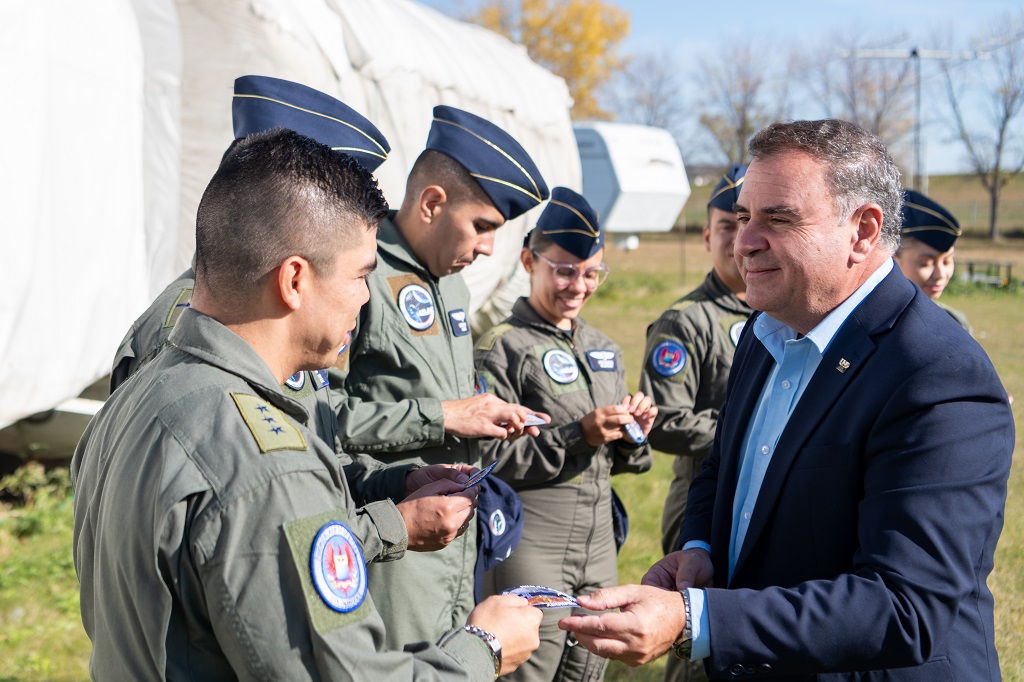Misión cumplida: Colombian Air Force crew spends 13 days in UND Lunar/Mars habitat
Simulating a mission on Mars, the crew researched health, communication and other factors astronauts likely will encounter

By Averie Eixenberger
In late October, five officers from the Colombian Air Force completed a two-week mission within the UND Aerospace Integrated Lunar/Mars Analog Habitat (ILMAH).
The group of five spent 13 days within the ILMAH, simulating a mission on Mars and conducting research from within while a sixth member supported the group from the ground.
The team egressed into a cold morning with smiles on their faces and a perky “Good Morning!” from Capt. Diego Ernesto Cortés Guaje, commander of the mission. Members of the group remarked that this was their first time seeing snow.
The team included:
- Diego Ernesto Cortés Guaje – commander
- José David Ortega Pabón – communication officer
- Brian Ingerman Sánchez Ayala – medical officer
- Second Lt. Indrid Xiomara Bejarano Cifuentes – aerospace engineer
- Second Lt. Joseph Néstor David Sequeda Ramón – data officer
- Lt. Jeimmy Nataly Buitrago Leiva – mission support officer

“It was amazing,” said Cortés Guaje. “We learned a lot and developed a briefing for each mission. Overall, it was a big success.”
The group researched various topics within the habitat to gather more than a thousand pieces of data. The plan is to use take this data back to Colombia for further analysis.
“It gives us ideas for future missions,” said Cortés Guaje. “Now we know what software to develop.”
Each member of the crew was responsible for conducting a different “mission” or research project. One focus of each crew member was on communication, both with each other and with Mission Support outside the habitat.

Members of the crew studied extravehicular surface communications and task loading for operations outside the habitat in rovers and space suits, as well as the effects on communication hardware from vacuum chambers. They also coped with 10-minute delayed communication with Mission Support, which simulates the time it would take to send messages from Earth to Mars.
“We tried to get ahead of the message,” said Cortés Guaje. “We would send the message 10 minutes before we needed the response, and would try to figure out how to solve any problems we had on our own first.”
Other topics studied during the stay included the effects of isolation on crew mental and physical health, as well as the effects of exercise on fitness, diet and overall crew wellbeing.
“On the fourth day, we felt really slow and tired in the morning,” said Cortés Guaje. “We noticed that our heart rate lowered as the mission went on.”

The crew was also responsible for growing and overseeing plant care within the habitat. Bejarano Cifuentes, the aerospace engineer, spent significant time with the plants in the Plant Production Module.
“I loved working with the plants,” Bejarano Cifuentes said. “To me it was amazing, because I would say ‘hello’ and talk to them.”
While the crew was often busy with tasks, they also took time for themselves, spending time together watching movies.
With the mission completed, the members placed their mark on the rover hatch in the Core Module, adding theirs to the list of successful missions within the habitat.
Moving forward, the habitat will continue to support experimenters from not only the United States but also around the world in the preparation for long duration spaceflight. The facility plans to host at least four simulated missions in 2024.
 About the author:
About the author:
Averie Eixenberger is a Commercial Aviation and English major at UND. After graduation, she hopes to pursue a career as an airline pilot and work within aviation journalism.


